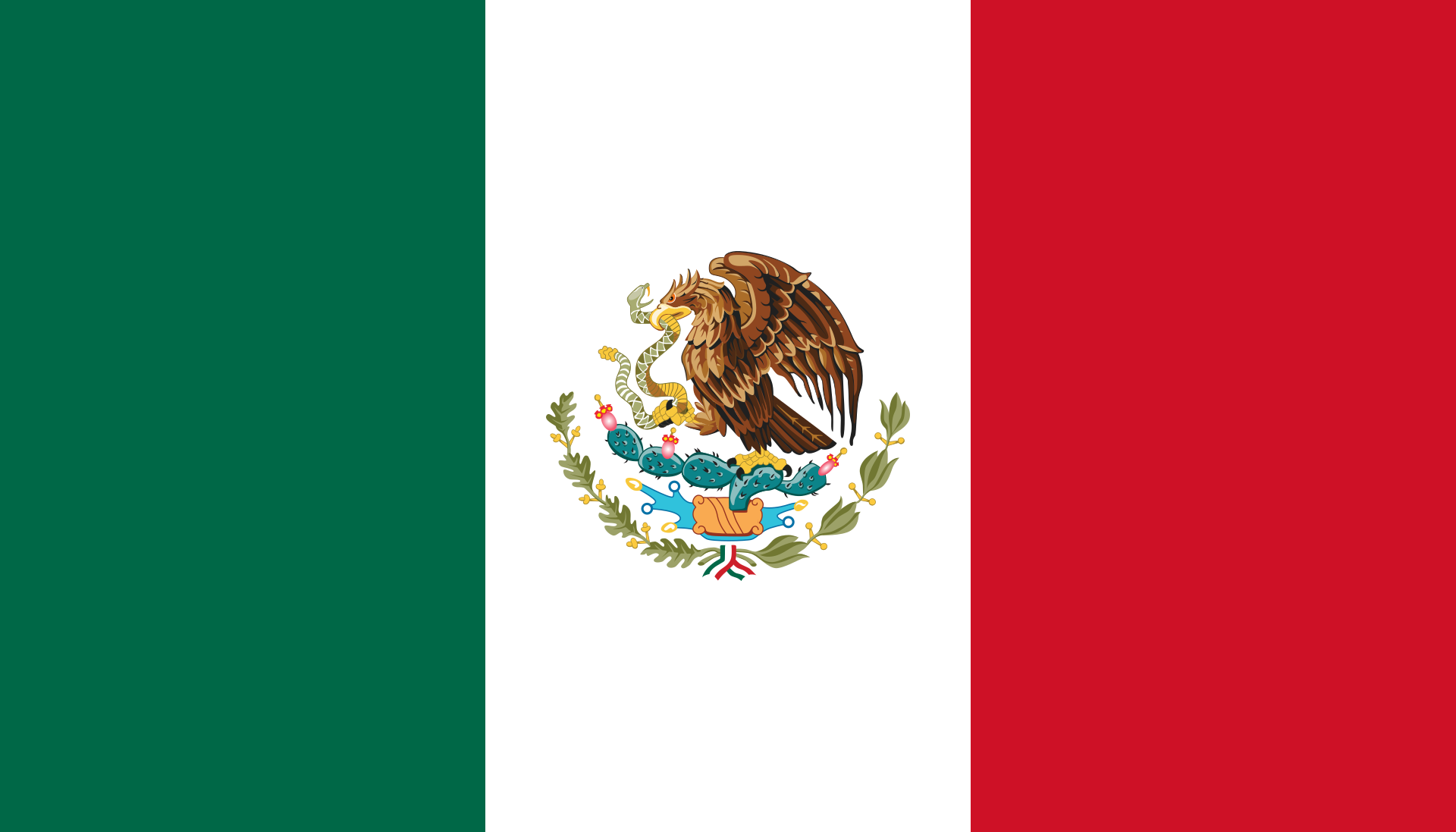National Symbols: Flag Details
Date First Used
1821 (current version adopted September 16, 1968)
Nickname(s)
None
Design Elements
A vertical tricolor of green (at the hoist), white, and red with the Mexican coat of arms charged in the center. The coat of arms appears the same on the reverse side (back) as it does on the obverse (front) side.
Symbols: The central emblem, based on an Aztec legend, features an eagle holding a serpent in its talons, perched on top of a cactus; the cactus is situated on a rock that rises above a lake.
Colors: Red, white, and green are the colors of the National Liberation Army in Mexico. Green stands for hope, white for unity and purity, and red for religious piety and the blood of national heroes.
Proportions: 4:7
Variations: The presidential flag consists of the tricolor green, white, and red with the crest appearing in gold and silver. A flag used mostly by state governments and federal bodies features an entirely gold crest.
History
Mexico’s independence has been hard won, and the various permutations of the country's tricolor flag reflect many political changes. The tricolor flag has been altered four times. While it was never adopted officially, many consider the first Mexican flag the Standard of the Virgin of Guadalupe. The Standard served as the initial symbol of the rebel army during the Mexican War of Independence, which began in 1810. The first official national flag—the tricolor flag of green, white and red charged with the national coat of arms—was established in 1821, the first year of recognized Mexican sovereignty. While similar to the national flag that is used today, it features a distinct difference: a crown affixed to the head of the eagle.
The second national flag was adopted around the same time as the establishment of the first federal republic in 1823, when the crown was removed and other changes to the crest were made. The third official national flag was that of the Second Mexican Empire. This design, ordered by Emperor Maximilian, gave the coat of arms a look similar to the French Imperial arms, with a bit of "Mexican flavor" added to the mix. That flag was abandoned in 1867 when Maximilian was overthrown and executed. The second national flag was adopted once again as the national flag, although never officially. Finally, the current national flag, adopted on September 16, 1968, adapts the design approved by presidential decree in 1916, when the eagle was changed from a front-facing to a side-facing position. This change helped mark Mexico City's hosting of the 1968 Summer Olympic Games, when the revitalized ancient Aztec city of Tenochtitlan announced its triumphant ascendence to the modern world stage.
Proper Uses
The Law on the National Coat of Arms, Flag and Anthem (1984) contains seven chapters, a preamble, and a section that contains the lyrics of the national anthem. It describes, among other provisions, what days the flag is required to fly at either full or half-mast (with additional days to be decided by presidential decree). According to the law, it is compulsory for all educational institutions, public or private, to display the flag. Private individuals are allowed to display the flag as well, but must “observe the respect that corresponds to the national symbol.” When the flag is paraded in front of a crowd, civilians salute by standing at attention, raising their right arms and placing their right hands on their chests, in front of the heart, with the hand flat and the palm facing the ground. This salute is known as the "El saludo civil a la Bandera Nacional" ("The Civil Salute to the National Flag").
Legends, Controversies, and Trivia
The coat of arms pictured on the flag is derived from an Aztec legend. According to that legend, the gods told the Aztecs to build a city where they spotted an eagle and a serpent. After hundreds of years of wandering, they settled on a small, swampy island in Lake Texcoco. They named their new home Tenochtitlan ("Place of the Prickly Pear Cactus"), and in 1325 built a city on the site on what is now the center of Mexico City.
Popular Mexican singer Paulina Rubio came under fire from the Mexican media in October 2007 when she appeared draped only in a national flag in the Spanish-language edition of Cosmopolitan magazine. Some Mexicans considered this act desecration, which is outlawed under the Law on the National Arms, Flag, and Anthem. She later apologized.
In 1999, President Ernesto Zedillo started a program of erecting giant flags across the country. These banderas monumentales (“monumental flags”) were placed in various cities and spots of national significance, like Mexico City, Tijuana, and Veracruz. The decree stipulated the flags measure 14.3 by 25 meters (50 x 82 feet) and be raised on flag poles 50 meters (164 feet) high. One exception is the flag located at the Mirador del Obispado in Monterrey. Located 775 meters (2,542 feet) above sea level atop the Cerro del Obispado, it measures 50 by 28.6 meters (164 x 94 feet) and weighs 230 kilograms (507 pounds)—four times the size of most other banderas monumentales.
At the time of the flag's adoption, the Italian tricolor was not in use. Since then, to distinguish it from Mexico's own similar tricolor, the Mexican flag now contains the coat of arms.
Copyright © 1993—2024 World Trade Press. All rights reserved.

 Mexico
Mexico 